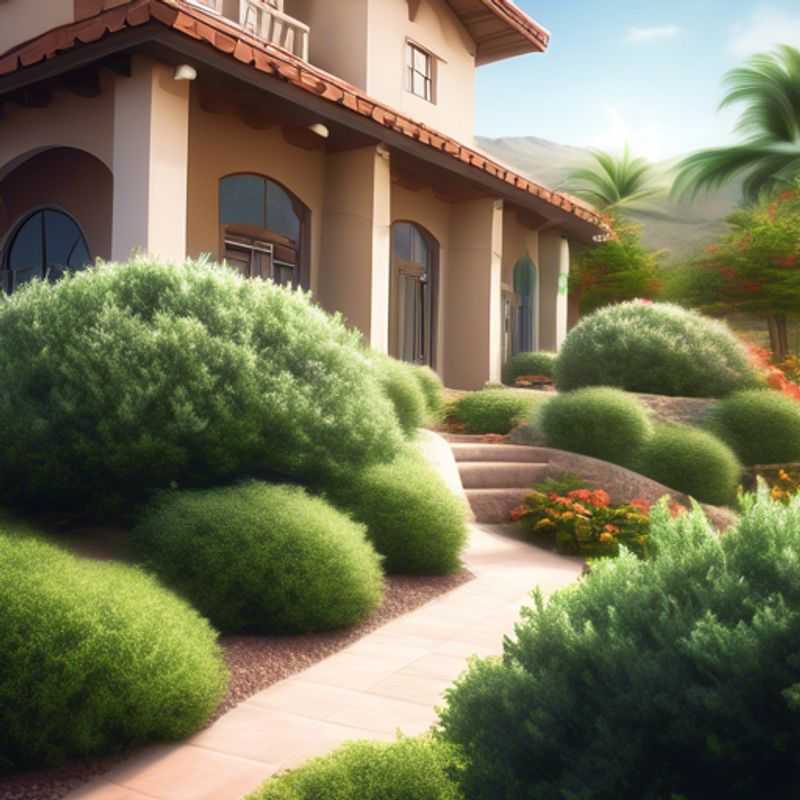Top Things to Know Before Buying Low-Growing Shrubs for Your Front Yard

Top 7 Things to Know Before Buying Low-Growing Shrubs for Your Front Yard
Choosing the perfect low-growing shrubs for your front yard can truly enhance your home's curb appeal. But before you head to the nursery, there are some key considerations to ensure you select the right shrubs for your space and lifestyle.

Shrub Sizing: Choosing the Right Plant for Your Space
When planning your garden, it's crucial to consider the mature size of shrubs you want to plant. Knowing how big a shrub will grow is essential for ensuring it fits comfortably in its intended space. This prevents overcrowding, damage to surrounding structures, and ensures the shrub thrives in its environment.
Shrubs are generally classified by their mature height and spread, which is the horizontal distance they cover. You can find this information on plant tags, in gardening books, or online. It's important to note that growth rates can vary depending on the shrub variety, soil quality, and climate.
Once you know the mature size, you can determine if the shrub will have enough space to grow. If it's too close to a house, fence, or other plants, you might need to choose a different variety or consider pruning to maintain its size.
Remember, planting shrubs too close together can lead to competition for resources, potentially hindering their growth and overall health.

Sun, Shade, or Somewhere in Between: Deciphering Your Shrub's Light Preferences
Determining the ideal sun exposure for your shrub is crucial for its healthy growth and flourishing. You can typically find this information on plant tags or online resources, but here are some key considerations:
Consider the shrub's natural habitat: Shrubs originating from sunny, open areas, such as meadows or deserts, are likely to thrive in full sun. Conversely, those from woodland environments generally prefer partial shade or even full shade.
Observe the leaves: Shrubs with thick, leathery leaves usually tolerate full sun, while those with delicate, thin leaves are better suited for partial shade.
Examine the plant's growth habit: Shrubs that tend to sprawl are more likely to thrive in full sun, while those with upright growth may prefer some shade.
Check the soil: Shrubs in dry, sandy soil often benefit from more sun, while those in moist, fertile soil may tolerate more shade.
Pay attention to your region's climate: If you live in a hot, sunny climate, your shrub may need more shade, especially during the peak hours of sunlight.
Experiment: If you're unsure, try planting your shrub in a spot with partial shade and observe its growth. If it appears to be thriving, you can gradually increase its sun exposure.

Understanding Your Shrubs: Evaluating Soil Type and Drainage Needs
Understanding the soil type and drainage needs of shrub species is crucial for successful planting and maintenance. It's like choosing the right foundation for a building – the soil provides the necessary support and nutrients.
Soil type refers to the texture and composition of the soil, which affects its ability to retain moisture, provide nutrients, and drain excess water. Different shrub species have different soil preferences. Some thrive in sandy soils, while others prefer loamy or clay soils.
Drainage refers to the rate at which water moves through the soil. Good drainage is essential for most shrubs, as it prevents root rot and other water-related problems. However, some shrubs are tolerant of wet conditions.
Before planting, it's important to assess the soil type and drainage in your garden. You can do this by digging a hole and observing the soil's texture, color, and drainage rate. If you're unsure, a soil test can provide valuable insights.
Once you know the soil type and drainage characteristics, you can choose shrub species that are well-suited to your garden's conditions. Selecting the right shrubs will increase their chances of survival and thriving.

Matching Shrubs to Your Climate: Understanding Cold Hardiness Zones
Choosing the right shrub for your garden is crucial for long-term success. Before you fall in love with a particular species, it's essential to research its cold hardiness. This crucial characteristic determines how well the shrub can withstand the cold temperatures of your climate zone.
There are several ways to research cold hardiness:
1. Consult Plant Hardiness Zone Maps: These maps, available online and in gardening books, divide North America into zones based on average minimum winter temperatures. Locate your zone and look for shrubs labeled as suitable for your zone or zones colder than yours.
2. Check Plant Labels: Reputable nurseries and garden centers label their plants with their cold hardiness zones. This is the most direct and convenient method.
3. Search Online Databases: Several websites provide information about specific plant species, including their hardiness zones. You can search for the shrub's name and look for information on its hardiness.
4. Contact Local Garden Clubs and Extension Services: These organizations often have knowledgeable experts who can guide you in selecting the right shrubs for your area.
By taking the time to research cold hardiness, you increase the chances of your shrub thriving and enhancing your garden for years to come.

Choosing the Right Shrub: Foliage Color and Texture
When selecting shrubs for your landscape, it's essential to consider the desired foliage color and texture. This aspect significantly impacts the overall aesthetic appeal and can be instrumental in achieving the desired look and feel for your garden. Here's a quick guide to help you decide:
Foliage color plays a crucial role in setting the tone of your landscape. Do you want bright and vibrant colors, or something more subdued? Consider the color scheme of your home and surrounding plants. For instance, a shrub with deep green foliage can provide a grounding element, while a shrub with colorful leaves, like purple or yellow, can add a pop of vibrancy.
Foliage texture refers to the surface appearance of the leaves. You can choose from smooth, rough, glossy, or even fuzzy textures. Texture adds depth and dimension to your landscape, creating visual interest. Smooth leaves provide a clean and polished look, while rough leaves offer a more rustic feel. Consider the overall texture of your landscape and choose shrubs that complement existing plants.
Remember, the foliage color and texture of a shrub can change throughout the year. Some shrubs have vibrant colors in the fall, while others have beautiful textures in the winter. Make sure to factor in the seasonal changes when making your selection.

Shrub Strategy: Planning for Growth and Maintenance
When planning for shrubs, understanding their growth rate and maintenance requirements is crucial. This knowledge allows you to make informed decisions regarding placement, spacing, and ongoing care. Here's a quick guide to help you:
Growth Rate: Different shrubs have varying growth rates. Some are fast-growing, reaching maturity quickly, while others grow slowly. Knowing the growth rate helps determine how long it will take for a shrub to fill in a space and if it will require pruning to maintain its size and shape. You can usually find this information on plant tags or online resources.
Maintenance Requirements: This encompasses various aspects, including pruning, watering, and fertilizing. Some shrubs require frequent pruning to maintain their shape, while others need minimal intervention. Watering needs vary based on the shrub's water tolerance and the local climate. It's essential to understand the specific needs of your chosen shrubs to provide adequate care.
Consider these factors when planning:
Sunlight: Ensure you plant shrubs in a location that meets their sunlight requirements. Too much or too little sun can hinder growth.
Soil: Shrubs have different soil preferences. Some thrive in acidic soil, while others prefer alkaline soil. Choose shrubs that are suitable for the soil conditions in your area.
Pest and Disease: Be aware of common pests and diseases that can affect your chosen shrub species. Select varieties known for their resistance to these issues, minimizing the need for costly treatments.
Cost: Factor in the cost of purchasing shrubs, soil amendments, fertilizer, and any necessary pest control products. You might also consider hiring a professional for initial planting or ongoing maintenance, depending on your skills and time constraints.

Landscaping Harmony: Choosing Shrubs That Complement Your Home's Architecture
Choosing shrubs that complement your home's architectural style can elevate your landscaping to a whole new level. It's about creating a harmonious visual connection between your house and its surroundings, much like a well-designed circuit board seamlessly integrating components.
For a traditional home, think of stately, evergreen shrubs like boxwood or holly. These shrubs, with their formal structure, mirror the classic lines of your home. For a modern home, opt for shrubs with clean lines and a minimalist aesthetic like Japanese maples or grasses, mimicking the simple geometry of the architecture.
Don't forget about scale! Consider the size of your shrubs in relation to your house. Too small, and they'll get lost; too large, and they'll overwhelm the structure.
Think about the texture of the shrubs. A home with a rough stone facade might be softened by the delicate texture of weeping willow or cascading hydrangeas. If your home features smooth siding, consider adding the visual interest of a spiky shrub like barberry or a prickly juniper.
It's also important to consider your climate. Selecting shrubs that thrive in your region ensures they'll flourish and continue to enhance your home's beauty for years to come.
Remember, this is just a starting point. The real magic happens when you personalize the process, blending your personal style with your home's unique features. Just like a skilled engineer selects the perfect components for a project, you'll select the perfect shrubs to create a harmonious and visually stunning landscape.
